February 2023
As societal challenges such as climate change continue to mount up, initiatives are being undertaken around the world, including the SDGs set forth by the United Nation toward the year 2030. If we are to face up to these increasingly complex societal challenges and build a sustainable future, the nations and regions of the world need to transcend their individual viewpoints so that we can all feel a sense of ownership of the problems and take action to find solutions. In this context, a hands-on event primarily aimed at teaching students from Generation Z and workers in their 20s about the environment, was held at SHIBUYA QWS, a venue for collaborative creation by industry, government, and academia. Meanwhile, the Research & Development Group of Hitachi, Ltd., an event co-sponsor, produced and exhibited educational resources that utilize XR. This article provides an overview of the event and describes the work Hitachi’s Research & Development Group has been doing to help resolve societal challenges.
 Mana Saza
Mana Saza
Director, SWiTCH Association of Sustainability
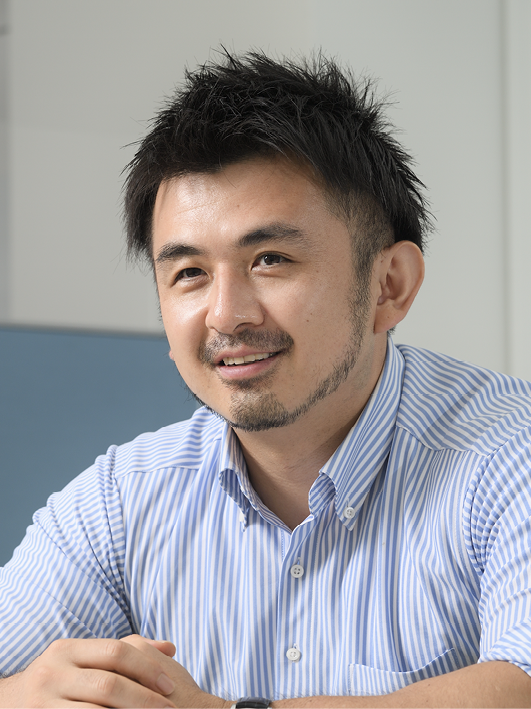 Kazuhiro Ikegaya
Kazuhiro Ikegaya
Senior Designer, Planetary Boundaries Project, Center for Sustainability, Research & Development Group, Hitachi, Ltd.
SWiTCH Meetup—Biodiversity(1) was a hands-on event for teaching people about the environment held at SHIBUYA QWS(2)*1 in October 2022. With “The future of food and biodiversity explored through dialogue with Generation Z” as its theme, the event was attended by six companies and organizations whose research and other work covers not only biodiversity, but also fields like food and the environment, providing a venue for them to showcase what they had been doing and for presenting their respective future plans. Mana Saza, Director of the SWiTCH Association of Sustainability*2, the event host, explained why they decided to host this event.
“It has been reported that climate change awareness in Japan fell by 8% between 2015 and 2021(3). While we talk about how our world is in a climate emergency at high-level dialogues, most of us have yet to make any changes in our lifestyle and work life. I expect that is because people do not realize the extent to which human action depends on nature-based resources. The “New Nature Economy Report 2020”(4) of the World Economic Forum states that half of global gross domestic product (GDP) depends on nature. While the number of companies taking action on decarbonization is growing, I suspect that recognition of the importance of biodiversity remains low and we are at the doorstep of shining light on 30 by 30, a goal to conserve 30% of land and sea by 2030. Accordingly, we decided to hold this event as a means of stimulating interest in the connection between humans and biodiversity through food. We wanted to provide an opportunity for people to confront societal challenges first-hand, identifying the specific problems we are talking about when we use this term, and asking how they affect us personally.”
The Research & Development Group of Hitachi, Ltd. participated in the event as a co-sponsor, with two groups putting on exhibits. One of these was Hitachi Kyoto University Laboratory(5) which produced and presented two immersive educational presentations using extended reality (XR). The presentations were entitled “AR & MR Contents to Deep Dive into Societal Issues” and “Carbon Offset Charger: Helping Reduce CO2 Emissions from Energy” respectively. Kazuhiro Ikegaya, a Senior Designer in the Research & Development Group at Hitachi, explained how it came to co-sponsor the event.
“When I was at the 26th United Nations (UN) Climate Change Conference of the Parties (COP26) in November 2021, in which Hitachi participated as a Principal Partner, Japanese high school students presented heartfelt expressions of how they feel about their own environment to the conference venue in Glasgow, UK. The passion in these messages was very moving and also got me thinking about what I could do as an adult and corporate employee. This led to a discussion with Saza-san, who attended COP26 as a Japanese youth representative, about whether there was something we could do together, resulting in holding this event, targeting Generation Z workers and other young people.”
When organizing the event, they looked at similar events put on by other companies. However, as Ikegaya went on to explain, rather than a program of one-way presentations, they wanted to give people an immersive experience.
“Through this event in Shibuya, which is known as a popular place for young people, we wanted to deepen our dialogue with the generation of youth who have a high level of environmental awareness. Fortunately, the wave of COVID-19 infections was waning and we were delighted to finally have the opportunity to provide an in-person experience.”
EXHIBITION 1: Hitachi Kyoto University Laboratory
Established on the Yoshida Campus of Kyoto University in 2016 with the theme, “exploration of basics and theory based on an understanding of humanity and culture,” Hitachi Kyoto University Laboratory engages in public research utilizing practices such as open forums. The laboratory has been studying the societal challenges that Japan can expect to face in 2050 and looking at where to start on finding genuine solutions. It has also put together a document entitled “Crisis 5.0”(6) describing an investigation into the underlying societal challenges that will pose a threat to people’s way of life in the future. In it, they talk about the challenges for 2050 Japan in terms of three things missing from people’s lives, a trilemma of having nothing to believe in, nothing to rely on, and nothing to do. These three fundamental problems are interrelated such that any attempt to avoid addressing one of them will only exacerbate the others. While urgent action is needed on individual issues such as Japan’s aging demographics, low birthrate, and overly urbanized population, solutions will be difficult to find without taking the overall structure of society into account when considering what to do.
To this end, “Beyond Smart Life—Curiosity-Driven Society,”(7) a book published by Hitachi Kyoto University Laboratory in August 2020, talks about the concept of “education to stimulate the imagination” put forward by Professor Mitsuyoshi Ueda of the Division of Applied Life Sciences, Graduate School of Agriculture, Kyoto University. In the book, Professor Ueda writes, “Along with the importance of bringing the arts and sciences together again and tying them back into society, we also need entertainment-based science education that makes the sciences more accessible.” To put these words into practice, Hitachi Kyoto University Laboratory has partnered with Kyoto University students and teachers and the Research Institute for Humanity and Nature (RIHN) to develop the “AR & MR Contents to Deep Dive into Societal Issues,”(8) a new educational resource that utilizes digital technology. It uses extended reality (XR), which includes virtual reality (VR), augmented reality (AR), and mixed reality (MR), to provide a realistic experience with the aim of stimulating people’s curiosity about societal challenges and practices. The primary aim is to get people to feel a sense of personal relevance and ownership about these challenges.
A more detailed account of how this project came about and the concepts it embodies can be found in another Open Innovation Hotline article in the web edition of Hitachi Review, entitled “Establishing Practices that Help People Take Ownership of Societal Challenges: AR & MR Contents to Deep Dive into Societal Issues.”(9)
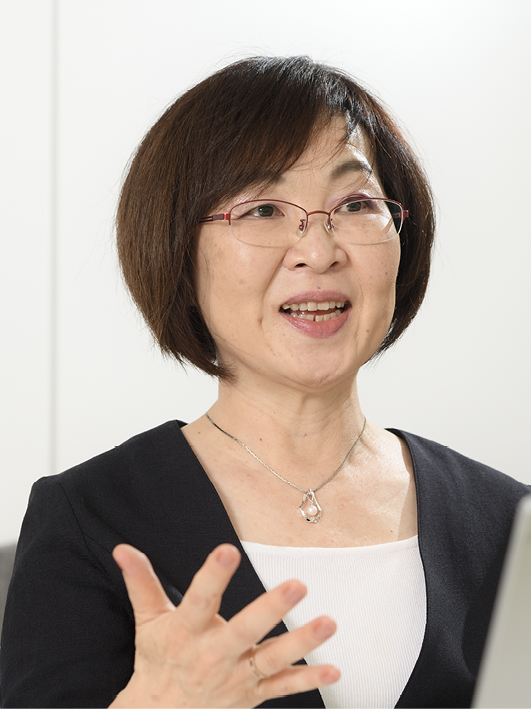 Saeko Okada
Saeko Okada
Associate Professor/Unit Manager, Public Relations Unit, Research Institute for Humanity and Nature
The event offered immersive sessions using MR. Each session started with the Hitachi moderator posing the question, “As climate change grows increasingly severe in the future, how will it change the meals that form an essential part of our daily lives?” One example that may result from the introduction of a carbon tax to counter climate change might be that the large amount of carbon dioxide (CO2) emitted in the production of beef will cause it to become a luxury item, whereas locally harvested seafood is available at comparatively cheap prices in coastal regions. While artificial meat may be available that has been manufactured from low-cost ingredients with a low impact on the environment, such as soyabeans and insects, to what extent will these alternative foods gain public acceptance?
The session participants wore visor headsets that projected images of beef, fish, soy meat, and food made from insects, displaying these on a tabletop so that the realistic appearance and prices of the foods would help them think about these questions more deeply. More than one person at a time was able to participate in a session, with everyone seeing the same scene. Participants could also pick up the projected images of bread or glasses by making a picking motion with their fingers.
The feedback from people who took part included such comments as, “I liked how the realism of what I was seeing helped me think about things like the benefits of choosing artificial meat or what compromises I am personally prepared to make,” and, “That was the first time I had tried XR and I was surprised at how real it seemed. The technology is fascinating and I expect it would be a fun way for children to learn.” Ikegaya played a lead role in producing the XR sessions and had the following to say about the participants’ feedback.
“As running the same sort of sessions with company staff would inevitably lead to talking about business matters, such as how the technology can be commercialized, I felt it would be valuable to avoid that altogether and instead put it in a context where interest in the presentation itself would predominate.”
Associate Professor Saeko Okada of RIHN, who was also involved in producing the sessions, commented as follows.
“For the organizers, the event proved to be a meaningful experience, giving us a chance to mix with a range of different people. I also gained a sense of their strong environmental awareness, with a lot of enthusiastic feedback from young children to Generation Z students and company employees. We also showed our Future School Lunch(10) sample meals*3 at the event and it was an opportunity to capture the interest of a large number of people. Although I had seen the AR content produced by Hitachi previously, this was my first chance to try the MR content. It was even more realistic than I had imagined and, in the future, I hope to be able to utilize this advanced technology in presenting the research work we are doing at RIHN.”
While the immersive XR metaverse sessions at this event took place under the guidance of a moderator, Hitachi Kyoto University Laboratory has also produced and made available two electronic picture books on the themes of two societal challenges, “Climate Crisis” and “Pandemic.” These are easily accessible to anyone with a smartphone or personal computer.
Example of What Users See in an XR Session 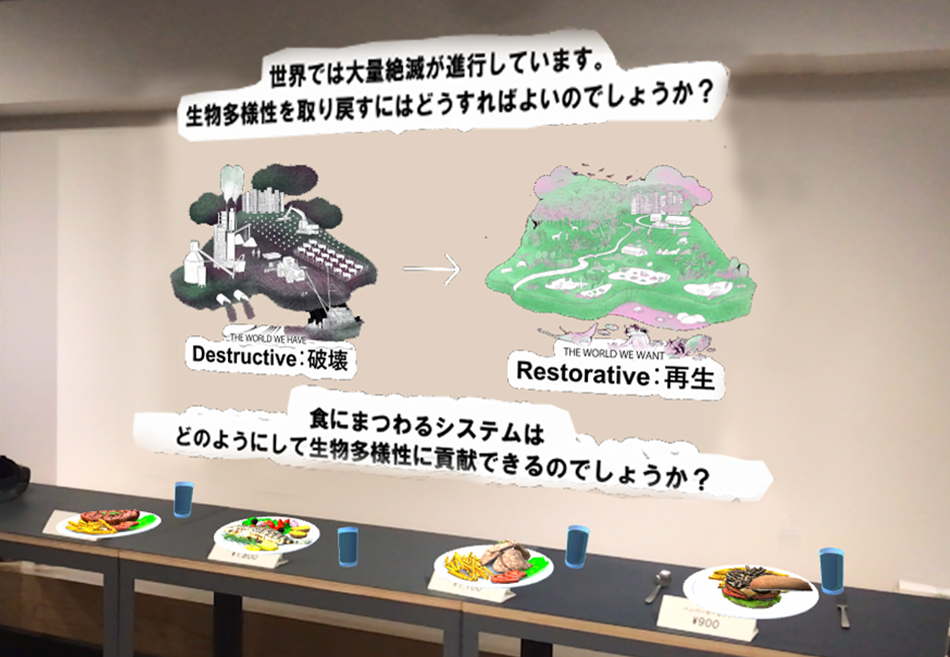 Participants wear a special MR device to enter the metaverse 3D virtual space and get a more realistic experience of the future possibilities for food.
Participants wear a special MR device to enter the metaverse 3D virtual space and get a more realistic experience of the future possibilities for food.
XR: extended reality MR: mixed reality 3D: three-dimensional
Sample Meal Representing a “Future School Lunch” 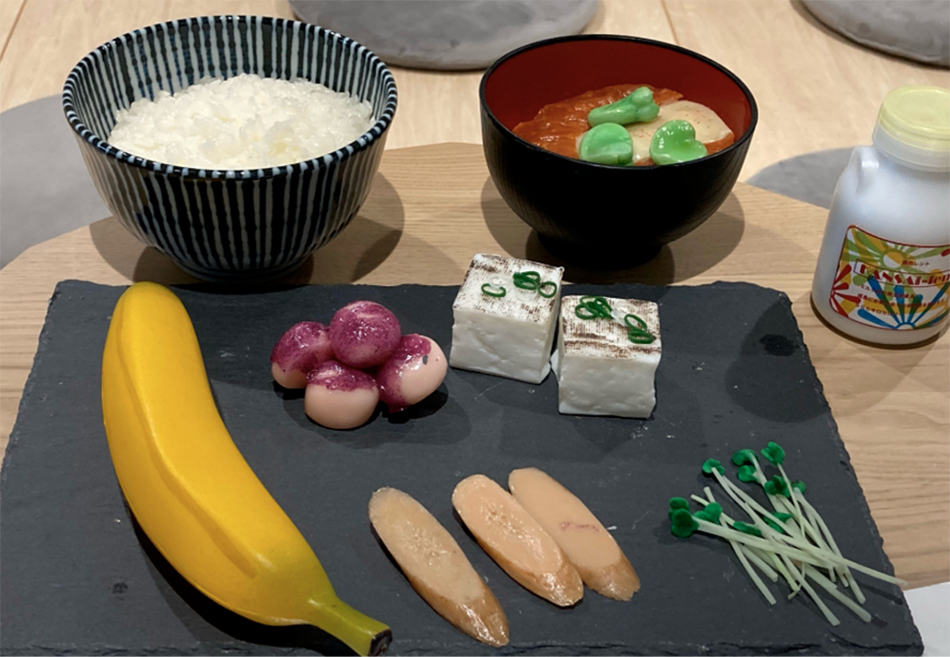 Sample meals produced by the Future School Lunch project of the Research Institute for Humanity and Nature were exhibited at the conference. The sample meals were incorporated into an educational presentation using Hitachi’s XR technology.
Sample meals produced by the Future School Lunch project of the Research Institute for Humanity and Nature were exhibited at the conference. The sample meals were incorporated into an educational presentation using Hitachi’s XR technology.
EXHIBITION 2: Reducing CO2 Emissions from Energy
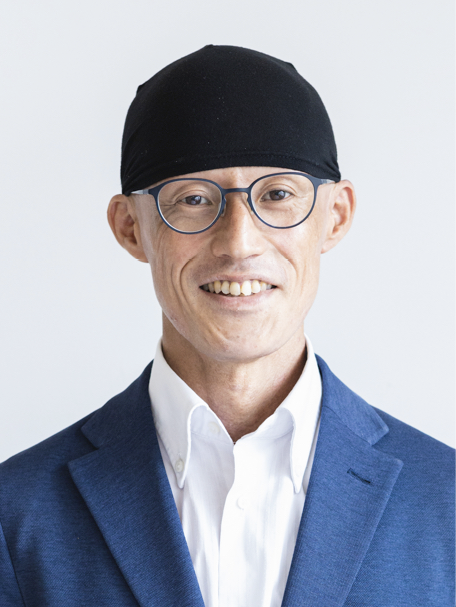 Michiki Nakano
Michiki Nakano
Senior Researcher, Global Center for Social Innovation – Tokyo, Research & Development Group, Hitachi, Ltd.
Entitled the Carbon Offset Charger(11), the other exhibit put on at the event by Hitachi’s Research & Development Group presented the concept for a service to help ordinary consumers offset carbon*4 and reduce the CO2 emissions from energy(12).
Billed as a fun and easy way to reduce the CO2 emissions from energy, the concept involves people using a specially designed alternating current (AC) adaptor to recharge their personal computers, smartphones, and other electronic devices. The charger enables them to visualize how much energy each of those devices is consuming and the service enables the carbon to be offset by purchasing an equivalent quantity of credits.
Michiki Nakano, a Senior Researcher at the Global Center for Social Innovation – Tokyo, Research & Development Group, Hitachi, Ltd., described the circumstances behind the development as follows.
“The concept was originally entered in the Make a Difference! idea contest run by Hitachi where it made the finals. While the initial idea was for a device to encourage the general public to change their behavior with regard to energy, the way the pandemic caused people to work in a much wider range of places made us wonder whether it could also prove worthwhile in business. Rather than just company offices, we recognized the need to think also about reducing the CO2 emissions from electricity that happen outside the office by staff working from home. It occurred to us that this could be done by using the charging system to measure the power consumption of devices used for work and to offset the CO2 emissions caused by staff.”
The way it works is very simple. Employees use the Carbon Offset Charger’s AC adapter to plug their devices into the mains electric power. When they do so, the charger records how much power is consumed and uses its Internet of Things (IoT) functionality to transfer this information to the app. The company then uses this data as a basis for purchasing credits, providing a simple way to offset the carbon.
As Nakano explained, “The idea behind the Carbon Offset Charger is to change people’s day-to-day behavior in a fun and forward-looking way. To encourage regular use, we made the app in a way that gamifies the experience, making it so that the more users contribute to the environment by using the charger, the more trees are grown.”
When the idea was presented to them, people at the event expressed an interest in using the charger themselves. One person commented, “The way the charger quantifies how much electric power I am using provides clarity when it comes to thinking about reducing CO2 emissions. It also makes carbon offsetting easy.”
Although the concept has not yet been commercialized, it has attracted attention, including winning a German iF Design Award. Hitachi intends to continue developing the system with a view to its use by individuals, including the addition of a function for selecting which carbon offsets to purchase.
Carbon Offset Charger AC Adapter and App Screen 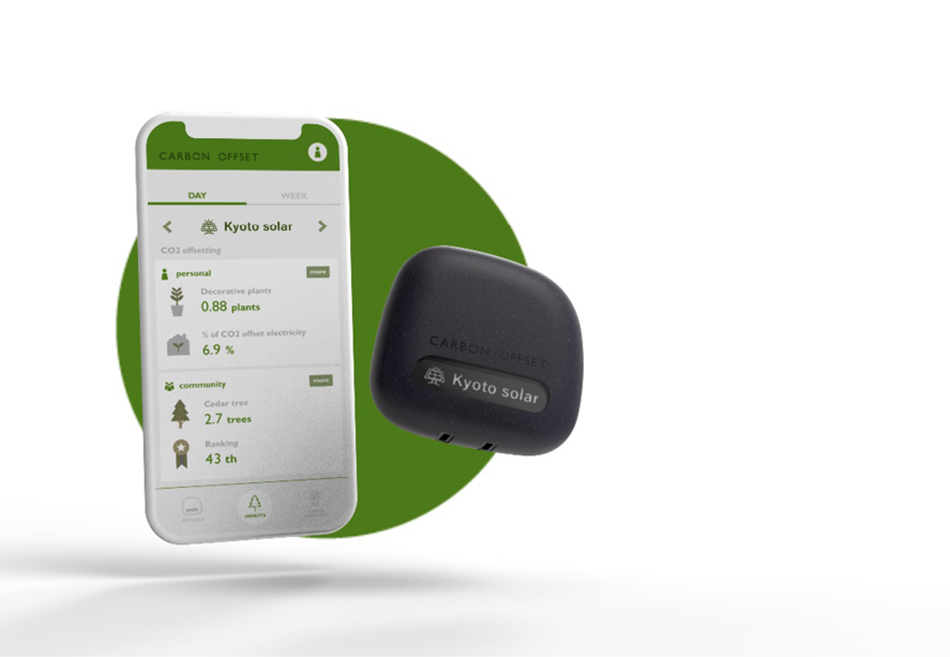 The LCD on the AC adapter shows the renewable power plant that is being funded to offset the electric power currently being used.
The LCD on the AC adapter shows the renewable power plant that is being funded to offset the electric power currently being used.
AC: alternating current LCD: liquid crystal display
Elevator Pitch by Research & Development Group, Hitachi, Ltd. 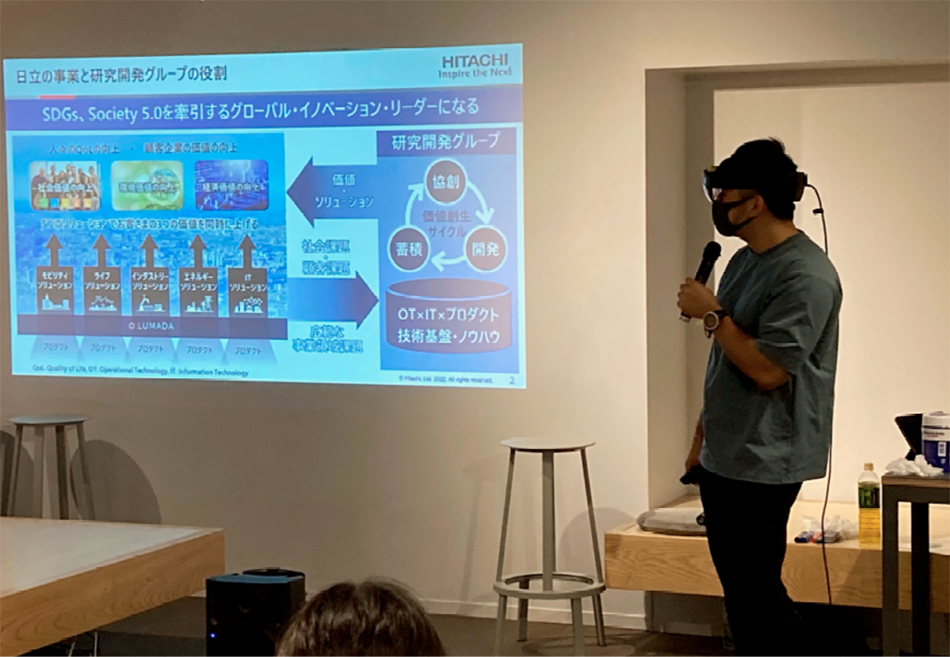 The event was interspersed with elevator pitches from the exhibiting organizations. While the event was primarily targeted at the younger generation, many participants interested in the environment, from children to adults, listened to what the speakers had to say.
The event was interspersed with elevator pitches from the exhibiting organizations. While the event was primarily targeted at the younger generation, many participants interested in the environment, from children to adults, listened to what the speakers had to say.
About 100 people attended the event, which maintained a welcoming atmosphere with ongoing conversations at every booth. The environmental awareness of the participants was evident in comments such as, “I am glad I attended as, even if you want to think about environmental issues, there is very little opportunity to do so when living in Tokyo.” Nevertheless, when you look deeper into it, the truth is that environmental issues remain “someone else’s problem” for many people. Unless everyone living on Earth takes on the issues with a sense of ownership, societal challenges like climate change is difficult to overcome.
SWiTCH Director, Saza put the case as follows, expressing her hopes for the actions Hitachi is taking on the environment.
“Hitachi is extensively involved in the social infrastructure that is essential to supporting a stable life. While they may not be aware of it, large numbers of people enjoy the benefits of the Hitachi technologies that provide the foundations of Japan. That is why I look forward to the contributions that Hitachi can make to Japan’s sustainability by transitioning all of its sectors to contribute to a climate-positive Earth and pioneering new partnerships including people from all walks of life to work in unison for the greening of our future for the future generation. The targets set out in the Paris Agreement cannot be achieved by the efforts of individuals on their own. We can think of the world we live in as a cruise ship. The passengers are trying to climb the ship’s stairs to move from third-class to first-class cabins in hopes to enjoy a richer life. Only to realize the ship has sprung a leak. Shouldn’t we be joining forces to prevent and repair the leaks in the ship of the world? I believe Hitachi has the power to grow such camaraderie and critically solve our planet’s crisis.”
Hitachi’s Research & Development Group plans to continue running immersive events to deepen its engagement with the young people of Generation Z, including a workshop on the environment to be held at the Central Research Laboratory in Kokubunji, Tokyo.